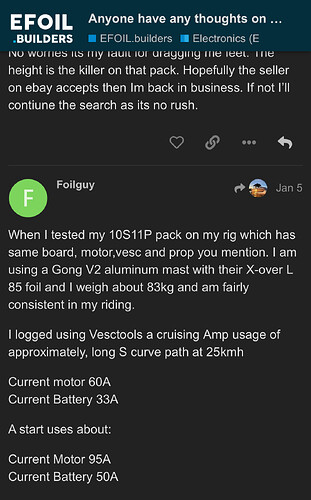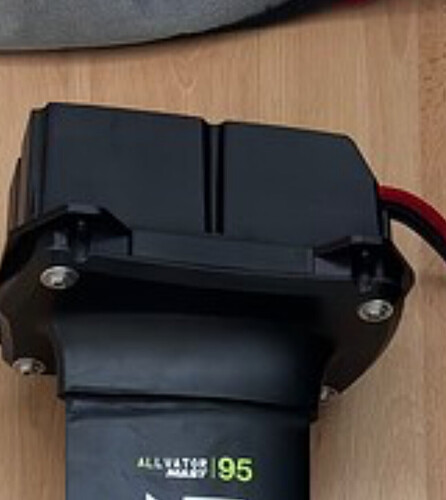Ok, so then this part is either fixed or was never part of the problem…
I’d say check again on the water or if possible in a rain barrel with the vesc tool attached and monitor the values
Interesting definition of “useless”.
IMO better to have over design - over capable components than the inverse.
You chose your battery design, VESC choice and motor based on your criteria. Thinking it useless now seems odd.
Once you get your issue resolved I think you will find your rig a lot of fun.
Yeah, probably. I am currently not even sure if it’s just the bigger motor being this power-hungry, while doing the same work as the smaller one. Although I am an electrical engineer and know that that can’t be the case, I can only really believe this when I finally have found the real reason for my powerloss…
I tested the motor now in a bin. I don’t really know what to report. I couldn’t really go to full throttle, since all the water would have swept over.
The absolut maximum I wen’t to in a burst was 79A, 2367W at a dutycycle of 75%.
Keep in mind it was in a German garbage bin, which can hold 120L.
Other datapoints are:
14A, 151W, 24%
23A, 299W, 30%
59A, 1539W, 62%
I will have to test int water in the next days to be certain if I made any meaningful changes. Maybe someone of you can see if my values are normal or not, but thanks for the help till this point to all of you anyways!
You don’t mention how you are seeing these values. Are they from the screen of the remote?
If you have vesc tools on a phone (either IOS or Android) you can create a log file that has a lot of info in it. Your vesc I believe has Bluetooth built in so you should be able to connect your vesc to the phone without acquiring anything more than the app itself. The file is CSV so you can either view it in the PC version of vesctools or open it in excel to get some real in use analysis.
If you put your phone inside the hatch of the Fliteboard you can record an actual on the water session. This can tell you what kinds of power demands are occurring when you start, and what they are at various board speeds.
A word of caution - Flipsky warned me about NOT running my 65161 out of the water for more than a few seconds as it might damage the waterproof seal.
My receiver is broken,I don’t get any information on my remote but am able to control the motor. I viewed the data on my phone using the vesc app. Will record the data next time on the phone to share with you guys.
With the Flipsky 75200 Pro (that I also use), I believe the bluetooth is built into the vesc unit itself and not part of the receiver board. You can test this with the vesc tools app easily. Just connect your battery to activate the vesc, open the vesc tools App on your phone, and search for a vesc to connect to. As long as you don’t have a house full of active vescs it should be easy to identify.
So as a point of reference.
I use a 100l Fliteboard, 10S11P 21700 cell battery that I max charge to 41 V, a Flipsky 75200 Vesc, Flipsky 65161 motor with a Fliteboard prop (no duct) a Gong V2 mast with a Gong XOver 1300 foil and I weigh 83kg. These are the values that I achieve
Yeah, I know. That’s where I got the values from. On the board from my friend the receiver is not broken and the values get display on his remote. We are both connected via UART.
I created a post with my receiver problem already, but I solved it with the help of the people here. If you want to read through it, here it is: Telemetry not working with Flipsky VX3 Remote
Thank you. On my friends board the remote shows the current. I am pretty sure that the remote shows battery (not motor) current. He has the same motor as I have and when I ride with his board (57kg rider weight) I draw 40-45A (2500-300W), not matter if foiling or not. That’s what’s strange as well, the current does not go down when foiling, only when decelerating/ riding slowly.
Also it’s way more than you pull, although I weigh way less than you…
I will test in a couple days with the new parameters I may or may not have changed today.
I also use a VX3 - UART remote so I can see the telemetry data but don’t look at anything other than speed, battery level and vesc temp. The numbers are quite small and my riding skills are not good enough to take my focus away for more than a glance or I find myself swimming ![]()
If I want to do any analysis the vesc log has more the enough data and records a gps track so I can correlate the numbers with what was happening on the water.
There are a lot of things that can affect power usage but my basic understanding is big power draw as the board gets up planing, the rider stands and the board starts to foil. Once up on foil and travelling at optimal speed for that wing and rider the draw is quite a bit less and stays fairly stable unless you are running with ior against wind or wave direction.
Perhaps you have now altered your vesc parameters for a better match for your motor. Only time on the water can answer that.
Comparing data with your friend might prove useful.
Get rid of the duct and improve the mast to motor interface. That will create improvements already. Get a better foil that’s more efficient and you’ll again see improvements. Graph your data so that you can see the changes in power vs RPM vs speed.
That spec doesn’t mean anything, as often on the chinese sites.
The 70165 numbers show higher power and almost same rpm, this means mean it must output higher torque. Higher torque means more current needed - but max current is lower… so sheet is not correct.
So, I managed to test the new parameters yesterday. Nothing changed.
Here is a log of one of my very short test rides: Vetr.at Log View
You can see, that the Battery and Motor current stay pretty constant at very high values. (70A battery current and 90A motor current).
With about 29km/h I am going rather sporty, but I also rode slower, like 20km/h and the current is way too high anyways. About 60A battery current at this slower speed.
The interesting thing is, that the current does not drop when foiling, It even goes up by about 5A!
Everybody else reports the current going down when foiling, which obviously makes sense, since the drag from the board is not present anymore.
I did not remove the propguard, but everyone else has one without a problem. I will remove it next time but I am sure, it won’t affect anything.
My friend has the same setup as me, we both build it at the same time.
He draws even more current than me (compared to me riding his board) (up to 100A battery current) because he is heavier. He has a bigger board and bigger wing, everything else is the same.
One thing I found strange, is that when uploading new firmware to the vesc, (which I did on the field to be able to set the vesc up from scratch, did not help) the recognized hardware is “75_300_R2”, although I have the 75200 Pro. Is that correct? I can’t even change that…
What is the material between the Gong mast plate and the surface of the Flite adapter plate?
My rig has the adapter plate flush with bottom of board and the mast plate sits directly on the adapter plate.
If you have eliminated the vesc parameters as a cause the next step would be to change the components.
Taking prop guard off costs nothing
Try a different prop (Flite prop doesn’t cost much)
Try a different foil.
Perhaps post a video of you actually riding might lend a clue
The material is Aluminium.
My friend has a different wing, same result. I will take the propguard of in the future, forgot the tools last time.
I still refuse to believe that the prop and the propguard are the cause. Two-bladed props are more efficient and the quy selling them also only uses 800w when foiling, he has a similar setup.
Here is a video of me riding the board from my friend, because my battery was already empty.
He filmed it with his fpv-drone but has to work a little on actually filming me while flying. Nevertheless cool video.

